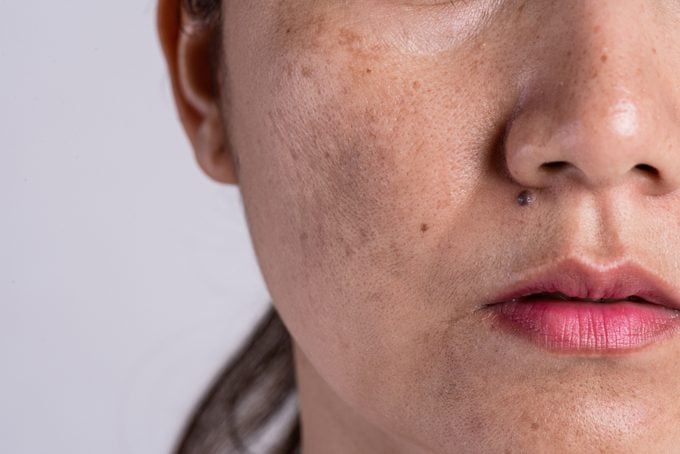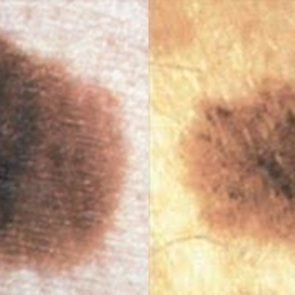What is Hyperpigmentation? What to Know About Dark Spots and Skin Discoloration
Updated: Jun. 01, 2021
Hyperpigmentation is when certain areas of skin turn darker. Learn about the different causes and the many different treatments for skin hyperpigmentation.
What is hyperpigmentation?
If you have dark spots on your skin or skin discolorations, you may have hyperpigmentation.
That’s when patches of skin become darker than the area around them for a number of different reasons, including hormones, acne scarring, or sun exposure. Changes to the melanocytes—the cells which produce skin pigment or color—are the immediate cause of hyperpigmentation.
But many different things can spur the melanocytes to start producing more pigment, says Michele S. Green, MD, a dermatologist with Lenox Hill Hospital in New York City.
Hyperpigmentation is rarely harmful, but is typically a sign of another medical issue. Doctors can successfully treat hyperpigmentation with prescription medications and in-office procedures.
Here’s what you need to know about hyperpigmentation.
Postinflammatory hyperpigmentation
Hyperpigmentation is the result of something else going on in your body, such as aging cells, hormones, or inflammation, says Carolyn Jacob, MD, a board-certified dermatologist with Chicago Cosmetic Surgery and Dermatology.
Experts recognize three basic types of hyperpigmentation: postinflammatory hyperpigmentation (PIH), melasma, and lentigines, or sun spots.
PIH is the most common type of hyperpigmentation. PIH develops after wounds, burns, or injuries—anything that causes an inflammatory reaction in your body. Acne scars, eczema and psoriasis can all cause PIH.
“Any kind of inflammatory insult in the skin can then lead to PIH,” says Chris Adigun, MD, a board-certified dermatologist with Dermatology & Laser Center of Chapel Hill in North Carolina. That’s because inflammatory cells flock to the area and stimulate pigment production. PIH can be temporary, but not always.

Lupus, psoriasis, eczema, and other inflammatory disorders can cause patches of darker skin, says Dr. Adigun. These are called primary inflammatory disorders of the skin.
Addison’s disease (when your adrenal glands don’t make enough of the stress hormone, cortisol) can cause darker skin all over your body. People with Addison’s secrete more of the melanocortin-stimulating hormone, which then spurs more melanin production.
This type of hyperpigmentation covers your whole body uniformly. Primary biliary cholangitis, a liver disorder, can also trigger hyperpigmentation.
Melasma
This type of hyperpigmentation usually shows up on your face and is more common in women than men, says Dr. Adigun.
Like other types of hyperpigmentation, melasma more commonly occurs in people with darker skin but can happen in all skin types. These patches can look a lot like age spots, but are usually darker.
No one really knows what causes it but hormones from pregnancy (called the “mask of pregnancy”), hormonal birth control, and hormone replacement therapy, are often involved.
“Hormones are revving up the cells that create color,” says Dr. Jacob. And the sun aggravates this, adds Dr. Green.
Lentigines or sun spots
These are age spots or liver spots that show up uninvited in middle age then multiply as you get older.
“Over time, from chronic sun exposure, your skin will develop these pigmentation spots,” explains Dr. Adigun.
They’re known as solar lentigines and reflect DNA damage that occurred when you were exposed to the sun. (Freckles are considered lentigines.)
Drugs, chemicals, and heavy metals
Foreign substances and medications can also cause hyperpigmentation. Some antimalarial drugs, the antibiotic tetracycline, amiodarone (a heart medication), and some tricyclic antidepressants have been linked to pigment changes. These look quite different from melasma and other forms of hyperpigmentation. Specifically, these medications induced pigmentary changes that can have a notable blue-grey hue.
In addition, many of these drugs can make you more vulnerable to the sun. Heavy metals like silver, gold, and mercury can also be to blame.
Hyperpigmentation and the sun
The sun can cause or aggravate hyperpigmentation of all types. That’s because melanin (pigment) absorbs ultraviolet rays as a way to protect your skin. That’s when your skin tans.
To avoid sun damage, wear sunscreen whenever you go outside. Look for broad-spectrum products to protect you from both UVA and UVB rays that have an SPF of 50 or higher, says Dr. Green.
And look for a sunscreen that’s anywhere from 20 to 25 percent zinc oxide, adds Dr. Jacob. “Hyperpigmentation is something that can easily come back. It’s stimulated by UV exposure so you have to have scrupulous UV and infrared exposure management,” says Dr. Green.
Diagnosing and treating hyperpigmentation
Doctors diagnose hyperpigmentation and its causes partly by examining the darkened area and taking a medical history. They may also perform a skin biopsy, removing a small piece of the discolored area to be studied under a microscope, says Dr. Adigun. That diagnosis will help guide treatment.
If there’s an underlying condition like psoriasis, doctors will treat that first. Beyond that, most treatments are similar, no matter the cause, says Dr. Green.
Even the cases that involve a primary inflammatory disease may involve additional treatment specifically for the skin. “Treating the underlying disease is going to give you better results,” says Dr. Adigun.
Medications
Most prescription creams used to lighten the skin contain hydroquinone which works by slowing down melanin production. In more severe cases, your doctor might suggest creams that contain tretinoin and cortisone.
It can take 3-6 months to see results and these can irritate sensitive skin. You can also try over-the-counter products with kojic acid that may help lighten your skin, says Dr. Jacob. (Learn more about skin care products for every skin concern.)
In-office treatments
Treatment for hyperpigmentation is usually a combination of methods, says Dr. Adigun. “They can be incredibly effective,” she says. These include chemical peels, laser treatments, and microneedling.
When to contact a doctor
Most cases of hyperpigmentation are medically harmless. If darkened spots on your skin are bothering you, you should contact a dermatologist about treatment. If the patches are accompanied by other symptoms like weight loss and fatigue (Addison’s), you should seek help.
Consult a doctor if you have pigmented spots that develop in areas that didn’t have a rash or previous marking. That could be cutaneous T-cell lymphoma, says Dr. Adigun. “The proper diagnosis is really needed,” she says.
Next, here are the skin care tips dermatologists follow.






















